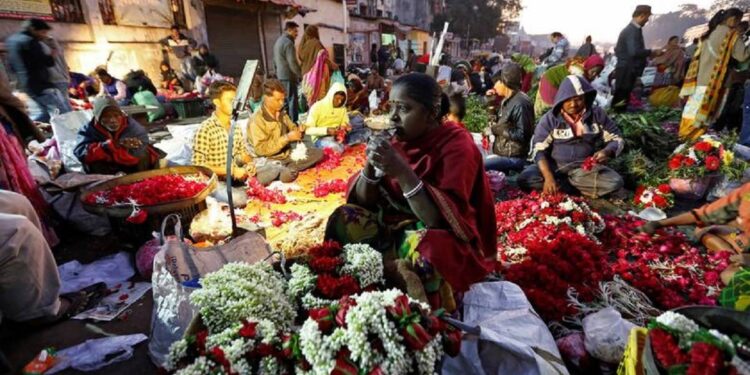 Street vendors in India.
Street vendors in India.(Image: REUTERS)
By Ashwajit Singh
The festive season in India is once again, inching nearer, posing as an opportunity for the country to hope for an economic revival. With the COVID-19 caseload across states and regions on a sharp decline and record vaccination numbers reposing faith in state capacity, the markets are expected to flourish with consumers again and bring new hope for economic glory. It is then that we must turn to over 40 crore of India’s informal workers facing economic peril post-pandemic. Of these, over 1.5 crore are unprotected makeshift workers of the street – from street hawkers, vendors and servicemen – including a substantial number of women and children ravaged by the pandemic-induced restrictions on their lives and livelihoods. We must contemplate if solutions for their re-integration in the fast-paced urbanising India shall emerge from the mercy of the state, or whether they shall come from innovation and adaptation, formalising the industry from within.
The post-pandemic plight of street vendors has pushed state governments to introduce stimulus packages, often relief in the form of credit loans. However, there remains a need to rope in direct transfer schemes to ensure that the vendor is equipped with an incentive to return to the urban economy, restarting and rebuilding from scratch.
As a breakthrough for state-led acknowledgement of their issues, street hawking has been recognised by the Supreme Court of India as a Fundamental Right in 2010. However, there remains a pressing absence of specific and pragmatic legislation in favour of dignified working conditions. GOI’s first legal recognition to the street economy came after the promulgation of the Street Vendors (Protection of Livelihood and Regulation of Street Vending) Act, 2014, that promised street vendors their own Town Vending Committees (TVCs), designated accommodations, and certificates of vending securing their economic rights. But definitional ambiguities in the Act alongside lack of adequate representation for the street vendors in the Committee have made it difficult for the legislation to be properly implemented.
A step forward has been the institutionalised support from the Centre through the PM SVANidhi Scheme that guaranteed low-interest collateral-free loans for a year in June 2020 for all applicable registered street vendors. The idea being formalisation of the sector with a provision of clear safety nets in light of the distress caused by the pandemic. Though over 45 lakh applications received by August 2021 in a 15-month odd span, just about 11% of all vulnerable street vendors from Category C and D have received the applicable loan amounts. Besides, the overall enumeration of beneficiaries only covers about half of all estimated street vendors in India. Having said this, while the actual implementation of the Scheme is rife with administerial challenges, there is no doubt that it can potentially lay the groundwork for the upliftment of the street economy in the most inclusive way possible.
Besides, proper implementation of these legislative instruments must encompass a bottom-up approach, with the state accompanying efforts by civil society organisations and local NGOs on ground in roping in the street-economy agenda, as they often attempt to raise tangible issues of concern. Street surveys can also aim to cover as many numbers of beneficiaries and vital statistics as possible to ensure that state-sponsored policies unfailingly touch the vendors on the very last mile of the realm.
The street economy must be overhauled from within to adapt to the changing times. For a start, states and subsequently, TVCs, can look to demarcate specific vending zones around the city that adhere to sanitary practices and social distancing, encouraging pandemic appropriate behaviour. This will help distribute the burden of responsibility between vendors, the consumers and the state, and dilute local stigma around street vendors to gather increased public trust in their cause.
Amidst the current deficit of information around the intricate issues faced by these marginalised workers, often the best solutions emerge from their own experience. Exposure to e-commerce, technical wherewithal and funding will help leverage the commercial as well as traditional essence of street vending practices and empower the mobile hawker to resolve issues it understands best. The street hawker must be perceived and treated as an entrepreneur in the making, in them lies the opportunity of innovation, reinvention and transformation. Largely, support must aim at pushing these entrepreneurs in the right direction, encouraging them to interact and develop strategic collaborations that can capitalise on the existing circumstances, and calibrating these scattered modes of living into a full-fledged specialised industry running entirely from the street.
As experts apprehend the pandemic’s third-wave without any certainty on its date of arrival, the question of its implications for the lower-middle-income groups is yet to be answered. While the existing relief from the pandemic will pave the way for some level of economic security, it is the street economy that must be harnessed to effectively contribute to economic prosperity at the national level. More importantly, this newfound prosperity must touch the lives of all stakeholders in the local arena, be it the rickshaw pullers, the potters, or the street food hawkers. This is where the citizens must come forward. Buying locally will facilitate India’s tryst with self-reliance and strengthen local supply chains to innovate and capitalise, even in these unfavourable times.
Inclusive, market-led sustainable development will, ultimately, arrive with the empowerment of our street entrepreneurs struggling at the very last mile. True self-reliance will come once we uplift these local bearers of our economy, once we stop taking for granted the pandemic plaguing our immediate peripheries for all these uncounted years.
(Ashwajit Singh is the Managing Director, IPE Global, an international development consulting firm)














